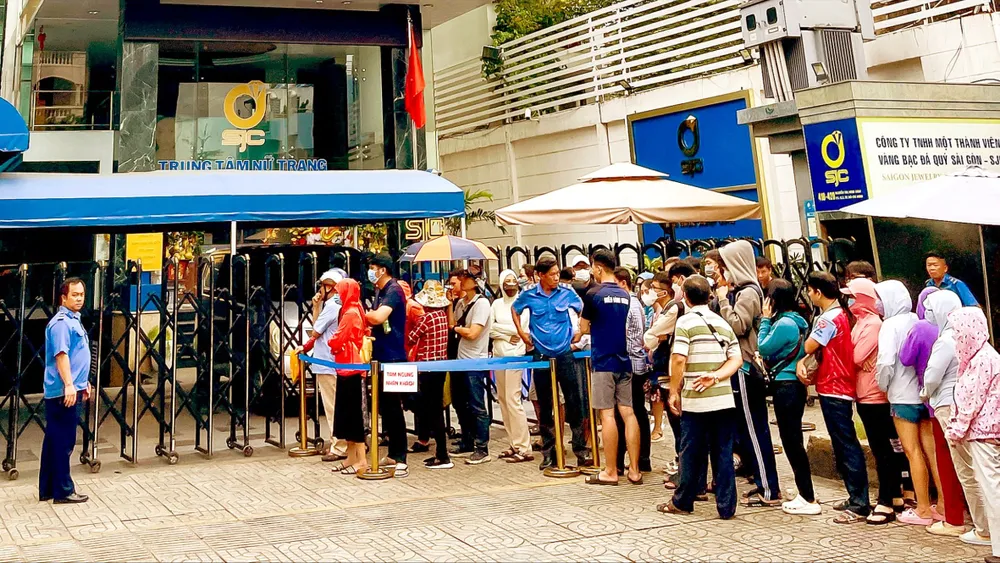
Despite the fervor, experts caution that buying gold only proves beneficial when held long-term, while short-term investments or speculations come with significant risks.
The Rapid Rise and Volatility of Gold Prices
Since early June, the sight of people lining up to purchase gold from the crack of dawn has been common at the selling points of four state-owned commercial banks (Vietcombank, VietinBank, Agribank, BIDV) and the Saigon Jewelry Company (SJC). These entities are part of a gold price stabilization program under the direction of the State Bank of Vietnam.
Despite the stabilizing efforts, gold sales remain limited, with units issuing only 50 gold purchase order numbers each day. This restriction has forced many prospective buyers to return multiple days in a row without success. Initially, there was no limit on the quantity sold, but now each person can only buy a single unit.
To alleviate the queuing situation, on June 12, Vietcombank introduced an online registration system for purchasing SJC gold bars, allowing customers to select a store, time, and date to pick up their gold. Despite this effort, many were still unable to log in and resorted to queuing at the physical points of sale, some arriving as early as 3-4 am.
Notably, even VIP customers with priority access to gold bars are restricted to buying one unit and must wait in line like everyone else. The queues result from various needs, such as storage, gifting, debt repayment, or purchasing on behalf of others. The commission amounts, price differences, and specific purposes of these purchases often remain unclear.
Gold is a traditional investment channel, particularly favored by older investors for its perceived safety. Younger investors typically prefer high-risk assets for better returns. However, the recent gold rush has attracted both demographics. The underlying question is why people are flocking to buy gold now.
Experts attribute the current gold-buying frenzy to the phenomenon of FOMO (fear of missing out), especially as SJC gold prices have skyrocketed to new historical peaks. The average gold price index surged by 22.95% in the first five months of 2024, tempting many into the market despite the inherent risks.
One significant risk is the disparity between domestic and international gold prices, previously fluctuating between VND 14-18 million per tael. The difference between the buying and selling prices of gold bars is also substantial, often exceeding VND 2 million per tael, and sometimes reaching up to VND 4 million per tael during peak periods. This large spread is mainly due to businesses protecting themselves from risks, effectively transferring these risks to buyers.
Moreover, gold bar prices can rise rapidly and fall just as dramatically. For instance, in May 2024, the global gold price peaked at USD 2,450 per ounce, pushing SJC gold bar prices to VND 92.4 million per tael on May 10. However, as the global price dropped to USD 2,300 per ounce, domestic prices also fell, with the State Bank of Vietnam stabilizing gold bar prices at VND 76.98 million per tael. Consequently, gold bars have depreciated by VND 15.4 million in just one month. Buyers who purchased at the peak on May 10 would face losses exceeding VND 17.4 million per tael if they sold now.
Caution Against Short-Term Investments
Dr. Trương Văn Phước, former Acting Chairman of the National Financial Supervisory Commission, emphasizes that while buying gold is a citizen's right, it carries significant risks. A single policy change, such as the Central Bank of China halting gold reserves purchases, can cause prices to plummet overnight (by USD 80-100). Similarly, gold prices are influenced by economic conditions in the US and Europe.
Currently, interest rates are rising, and if they return to favorable levels, investors might withdraw from gold, leaving those who bought at high prices bearing the risk.
Furthermore, on June 9, Governor Nguyễn Thị Hồng of the State Bank of Vietnam held a meeting to discuss gold market management policies and potential amendments to Decree No. 24/2012/ND-CP on gold business activities. During this meeting, Associate Professor Dr. Nguyễn Thị Mùi, a member of the National Fiscal and Monetary Policy Advisory Council, proposed that the State Bank should recommend the Ministry of Finance develop tax policies for gold. Implementing such policies could reduce speculative and hoarding behaviors, ultimately stabilizing the market.
Many countries already impose taxes on gold transactions. For example, in France, owners must pay an 11% tax on the total sale amount or 36.2% on profits from gold sales. Sellers are exempt from tax if they have held the gold for 22 years or more.
The current gold rush in Vietnam highlights both the allure and the risks of investing in this precious metal. While gold remains a traditional investment favored for its safety, the market's volatility and the substantial price disparities pose significant risks, particularly for short-term investors. Regulatory changes and tax policies might further influence the market dynamics, emphasizing the need for cautious investment strategies.
As the gold market evolves, investors must weigh the potential gains against the inherent risks and consider long-term holdings over speculative ventures. The allure of quick profits can be tempting, but the stability and safety that gold has historically provided are best realized through patience and strategic investment.




















